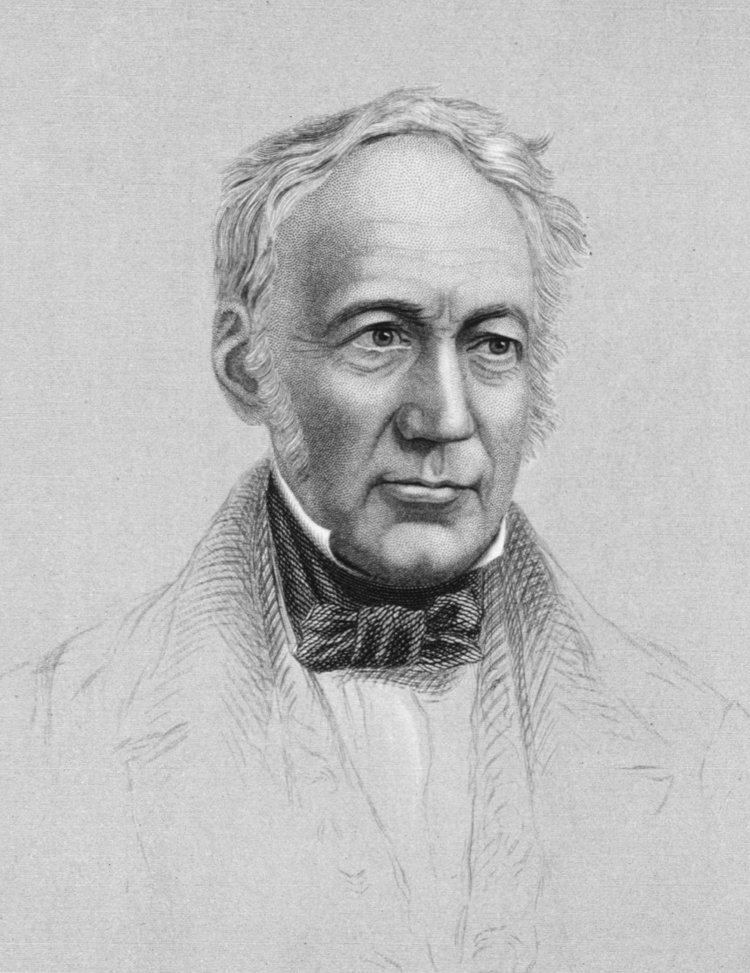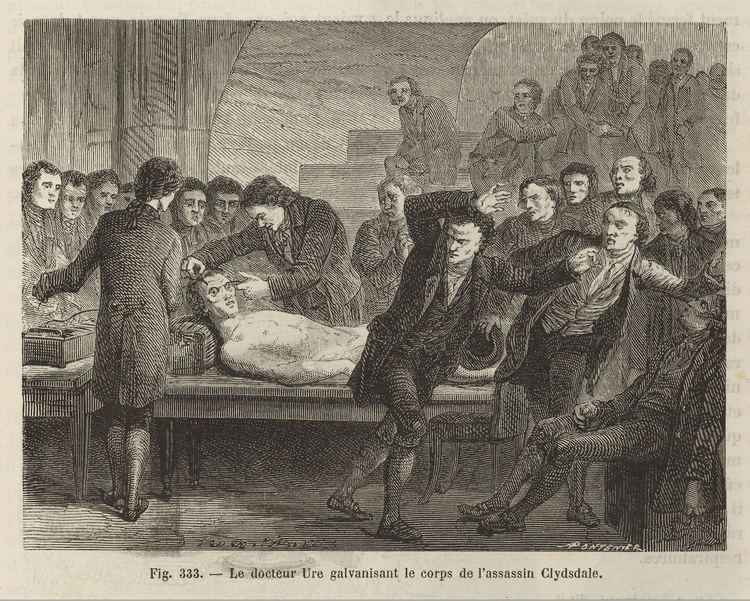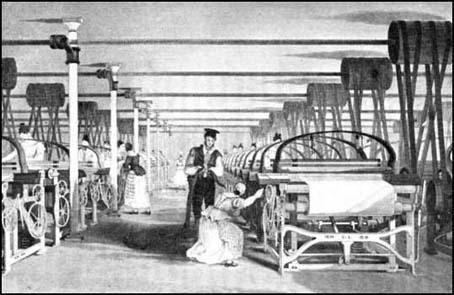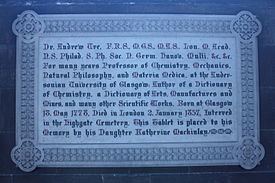Nationality Scottish Name Andrew Ure | Role Doctor | |
 | ||
Born 18 May 1778Glasgow, Scotland ( 1778-05-18 ) Died January 2, 1857, London, United Kingdom Fields Medicine, Chemistry, Natural philosophy Books Philosophy of Manufactures, A new system of geology, Dictionary of Chemistr, The Cotton Manufacture of Great B, On Gold and Silver: Mines an Similar People John Dalton, George Birkbeck, William Hyde Wollaston, Humphry Davy, George Gordon Byron | ||
World History Andrew Ure.m4v
Prof Andrew Ure FRS (18 May 1778 – 2 January 1857) was a Scottish doctor, scholar, chemist, Scriptural geologist and early business theorist.
Contents
- World History Andrew Urem4v
- DEMI EKSPERIMEN ILMUAN INI MENYAYAT TENGKUK MANUSIA HIDUP HIDUP SEKILAS TENTANG ANDREW URE
- Biography
- Geology
- Selected publications
- About Andrew Ure
- References

DEMI EKSPERIMEN ILMUAN INI MENYAYAT TENGKUK MANUSIA HIDUP-HIDUP ( SEKILAS TENTANG ANDREW URE)
Biography

Andrew Ure was born in Glasgow, the son of Alexander Ure, a cheesemonger and his wife, Anne. He received an MD from Glasgow University in 1801, and served briefly as an army surgeon before settling in Glasgow, where he became a member of the Faculty of Physicians and Surgeons in 1803. He replaced Dr. George Birkbeck as Professor of Natural Philosophy (specialising in chemistry and physics) in 1804 at the then recently formed Andersonian Institution (now known as University of Strathclyde). His evening lectures on chemistry and mechanics enjoyed considerable success and inspired the foundation of a number of mechanical institutions in Britain and the École des Arts et Métiers in Paris. He married Catherine Monteath in 1807.

Ure founded the Garnet Hill observatory in 1808. He was put in charge and resided in it for several years, leaving it second only to Greenwich in reputation at that time. Whilst in residence he was visited by Sir William Herschel, who gave some lectures to the local Astronomical Society and helped him to install a fourteen-foot reflecting telescope of his own [Ure's] design and manufacture. He was elected Fellow of the Royal Astronomical Society in 1811. Herschel's second son, many years later (in 1866), came to occupy Dr. Ure's Chair in Natural Philosophy.

In 1814, while giving guest lectures in Belfast, he did consulting work for the Irish linen board, devising an 'alkalimeter' which gave volumetric estimates of the alkali contents of industrial substances. This in turn led him to the concept of normality in volumetric analysis. He achieved considerable reputation for his practical chemistry.

In 1818 Ure revealed experiments he had been carrying out on a murderer/thief named Matthew Clydesdale, after the man's execution by hanging. He claimed that, by stimulating the phrenic nerve, life could be restored in cases of suffocation, drowning or hanging.

Every muscle of the body was immediately agitated with convulsive movements resembling a violent shuddering from cold. ... On moving the second rod from hip to heel, the knee being previously bent, the leg was thrown out with such violence as nearly to overturn one of the assistants, who in vain tried to prevent its extension. The body was also made to perform the movements of breathing by stimulating the phrenic nerve and the diaphragm. When the supraorbital nerve was excited 'every muscle in his countenance was simultaneously thrown into fearful action; rage, horror, despair, anguish, and ghastly smiles, united their hideous expressions in the murderer's face, surpassing far the wildest representations of Fuseli or a Kean. At this period several of the spectators were forced to leave the apartment from terror or sickness, and one gentleman fainted.'
In 1819 he divorced his wife, who had become the mistress of an Anderson's Institution colleague. In 1821 he published his first major book, Dictionary of Chemistry, a replacement for William Nicholson's outdated Dictionary. It came out two years after William Brande's Manual of Chemistry, and Ure was accused of plagiarism. Subsequently, Ure accused Dr William Henry and Thomas Thomson of plagiarism of his own works.
In 1822 he was elected a Fellow of the Royal Society. By 1830, Ure's outside interests led him to resign first from his chair and then from the Institution. He moved to London and set himself up as a consulting chemist (probably the first such in Britain). His work included acting as an expert witness, government commissions and industrial tours of England, Belgium and France. His visits to English textile mills led to his publication of The Philosophy of Manufactures (1835) and Account of the Cotton Industry (1836), dealing with the textile industry. In 1840 he helped found the Pharmaceutical Society.
His exposure to factory conditions led him to consider methods of heating and ventilation, and he is credited with being the first to describe a bi-metallic thermostat.
The great Dictionary of Arts, Manufactures and Mines, Ure's chief and most encyclopaedic work, was published in 1837 for which he received 1,000 guineas (worth about $30,000 in 2010). Further enlarged editions were rapidly called for in 1840, 1843 and 1853. After his death four further editions appeared, the last in 1878. This work was translated into almost every European language, including Russian and Spanish. The Times review said: "This is a book of vast research, and the variety of subjects embraced in it may be estimated by the fact that on the French translation it was thought advisable to employ nineteen collaborators, all regarded as experts in their special subjects." Historical accounts of the advancement of geology regularly make mention of Andrew Ure.
Ure died in 1857 in London. For much of his life he communicated regularly with famous scientists. Among his extensive circle of friends were principal scientists who grieved his death. Michael Faraday's posthumous description of him was:
…his skill and accuracy were well known as well as the ingenuity of the methods employed in his researches … and it has been stated that no one of his results has ever been impugned. His extensive knowledge enabled him to arrive at conclusions, and to demonstrate facts considered impossible by his compeers in science
He is buried in Highgate Cemetery. A secondary memorial was erected in Glasgow Cathedral by his daughter, Katherine MacKinlay.
Geology
Ure was a scriptural geologist and in 1829 published A New System of Geology, for which "he received 500 guineas (worth about $15,000 in 2010) and was elected an original member of the Geological Society." Ure promoted the study of geology, that "magnificent field of knowledge." However some criticised the book severely, and "The New System of Geology was not a success, even among readers who might have been expected to be sympathetic, and it was soon forgotten." because "the New System of Geology ... came just too late, at a time when the positions it so noisily defended were being quietly abandoned, leaving the author in slightly ridiculous isolation." Lyell's wrongly claimed that Ure wanted all the old-earth geologists "to be burnt at Smithfield." However, Ure thought both Werner's and Hutton's theories to be inconsistent with every principle of mechanical and chemical science. To establish a sound geological theory he believed that one ought to follow Bacon and Newton's example. He believed that since geology and the Scriptures were the work of God so when properly interpreted they would agree.
